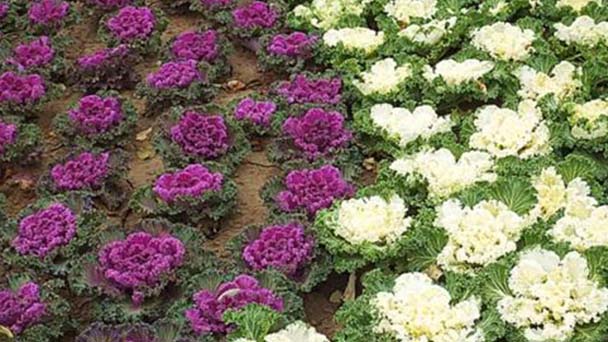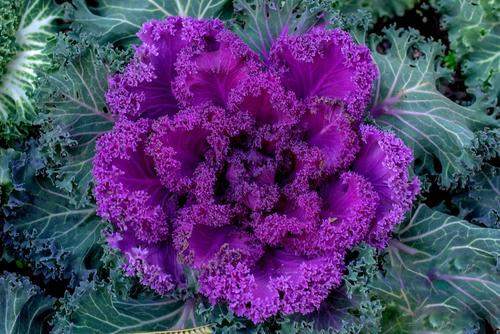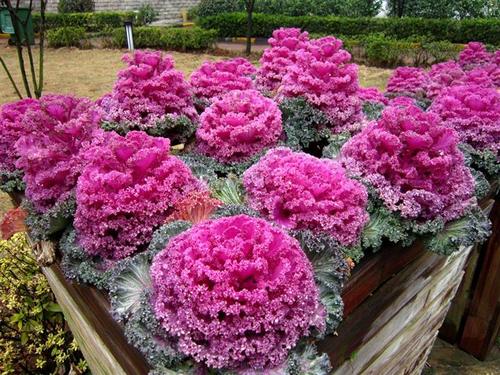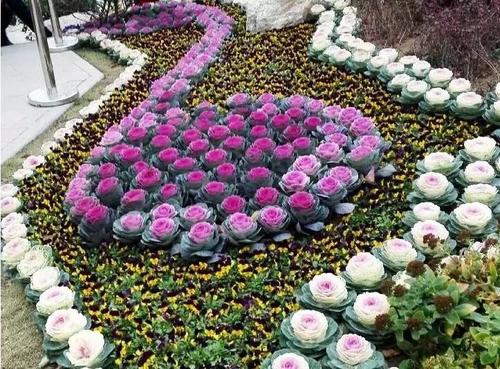Curly kale profile
Written by Maggie
Nov 08 2021

Curly kale, scientific name Brassica oleracea, is a variety of cabbage and is often found in flower beds, where it looks like a large, beautiful flower.
Curly kale picture

Curly kale characteristics
There are many ornamental varieties of Curly Kale, and the leaf shape is beautiful and changeable, and the color is gorgeous like flowers.Its central leaf color is particularly rich, the whole plant is shaped like a peony.
Curly kale (Brassica oleracea) is a tall plant with well-developed roots and is mainly distributed in plowing layers up to 30 cm deep. The stem is a short, dense leaf blade. Leaf-blade is hypertrophic, obovate, is a waxy powder, deep wavy fold, is bird feather shape, beautiful. Inflorescences are racemose, moth, fruit for pod fruit, oblate round, round seed, brown, 1000 grains weight about 4 grams.
Curly kale habits
Curly Kale (Brassica oleracea) is fond of cold weather. It is cold-resistant and can endure several short touches of frost. Curly kale has strong heat resistance, strong growth tendency, easy cultivation, sunny, saline-alkali tolerant and fond of fertile soil. The suitable temperature for growth is 20℃ ~ 25℃, and the suitable temperature for seed germination is 18℃ ~ 25℃.
The origin of Curly kale
Curly kale (Brassica oleracea) is origin from the coast of the middle sea to minor Asia, now widely cultivated, mainly distributed in temperate regions. In the United Kingdom, the Netherlands, Germany, the United States planted more, and the variety is different, there is Curly kale for viewing, there is Curly kale for vegetables. China has a short history of introduction and cultivation, especially for viewing Curly kale, there are only a few plants in recent decades, and they are only distributed in large and medium-sized cities such as Beijing, Shanghai, Guangzhou and so on.
The main value of Curly kale
Landscape application
Curly Kale (Brassica oleracea) is also known as "Leaf Peony" because of its abundant and varied leaf colors and shapes, including purple, green, red and pink at the margin, and light yellow and green at the surface.
Potted or arranged flower beds, flower beds. The leaves are graceful and elegant, and the cultivated landscape in clusters is particularly elegant.
Edible value
Curly kale (Brassica oleracea) is a rich source of nutrients, including a large amount of vitamins A, C, B2 and many minerals, especially calcium, iron and potassium. Vitamin C content is very high, the content of vitamin C in every 100 grams of tender leaves reaches 153.6 ~ 220 mg, in cabbage can be comparable to the broccoli. Curly kale calorie is only 209 joules, it is the ideal food for bodybuilding and weight loss.
Curly Kale (Brassica oleracea) allows continuous stripping of leaves and produces new leaves, which are served in sauteed dishes, salads, soups, and salads in Europe and the United States with colorful vegetables. Fresh flavor, after cooking to maintain a delicious green.
Ornamental value
Curly kale (Brassica oleracea) is an important material for winter flower beds in eastern China. Its ornamental period is long, the leaf color is very bright, in the park, street, flower beds common Curly kale edge and form a variety of beautiful patterns, used for the arrangement of flower beds, has a very high ornamental effect. Curly kale leaf color is diverse, there is light red, purple, white, yellow, etc., is the best-potted leaf view. At present, some ornamental Curly Kale varieties are sold in Europe, America and Japan for fresh cut flowers.

Curly kale growing methods
Sowing and raising seedlings:
Sow 288 holes on the plate, the soil should be thin, and keep the soil moist after sowing.
Curly kale can germinate in 4-6 days at 20-25℃, at which time the temperature can be adjusted to 15-20℃.
The EC value from seed germination to cotyledon development is about 0.75, and from cotyledon development to seedling growth, the EC value is about 1.0.
Water-soluble thin fertilizer (20-10-20,50ppm) can be applied appropriately after true leaves of Curly kale (Brassica oleracea) grow out. When the seedlings enter the rapid growth stage, the light should be sufficient, and the seedbed should also be kept dry to prevent the occurrence of tall seedlings and diseases.
30-35 days to be ready for transplanting.
Instructions for Serving Pots:
A container of 12cm or larger was selected for transplanting, and a mixture of loose, breathable, water-retaining and fertilizer-preserving substrates was selected as the medium, with pH5.7-6.4 and EC 2.0-3.5.
Cultivation management:
Keep 20-25℃ in the daytime and below 15℃ at night for about two weeks to promote the turning of leaves of Curly kale. At the early stage of seedling, lower temperature and humidity can prevent plants from growing inefficiently.
In the process of Curly kale (Brassica oleracea) growth, timely removal of old and yellow leaves at the base is conducive to plant growth and effectively reduce the occurrence of disease.
During the growth period of Curly kale, 200ppm 20-10-20 fertilizer was applied every week. In the later growth stage, lower fertilization concentration and night temperature were beneficial to the central leaves turning color. If a high concentration of topdressing has been maintained, it will affect the speed and degree of color.
If you want to get short plants, a seedling spray of B9 or a combination of the two can control plant height and promote leaf discoloration. Common diseases and insect pests of Curly kale: soft rot, downy mildew, cabbage green insect, aphids, and so on.
Curly kale flower language
Curly Kale's flower language and symbols represent interest, beauty, blessing, and good fortune.

Read Next:
15 Fall Vegetables to Plant for Your Autumn Garden
Latest Updated
- Benefits of Bugleweed - 7 Science-backed Health Benefits
- Bugleweed Dangers & Side Effects - Is It Poisonous?
- How to Plant Evergreen Trees - What You Should Know
- When to Plant Evergreens - Grow Guide for Evergreen Trees
- 12 Wonderful Evergreen Shrubs for Your Garden
- 12 Popular Evergreen Plants with Pictures for Beginners
- When And How To Prune A Lilac Bush Like a Pro
- How to Grow & Care for Lilac Vine (Hardenbergia Violacea)
- Japanese Lilac Tree (Syringa Reticulata) Care & Propagation Guide
- Shumard Oak Pros and Cons - What to Know
Popular Articles
- Winter maintenance of Antirrhinum Majus
- How to Grow Terminalia Mantaly Tree
- How to Grow and Care for Crossostephium Chinense
- How to grow Antirrhinum Majus in spring
- Peristeria Elata (Dove Orchid) Profile: Info & Care Guide
- Underwatered Snake Plant (Sansevieria Trifasciata) - Signs And How To Fix
- How to Care for Brazilian Jasmine Plant (Mandevilla Sanderi)
- How to Grow & Care for Graptopetalum Purple Delight in Summer
- Rosa Chinensis (China Rose): Plant Growing & Care Tips
- How to Care for Baby Sun Rose (Aptenia Cordifolia)